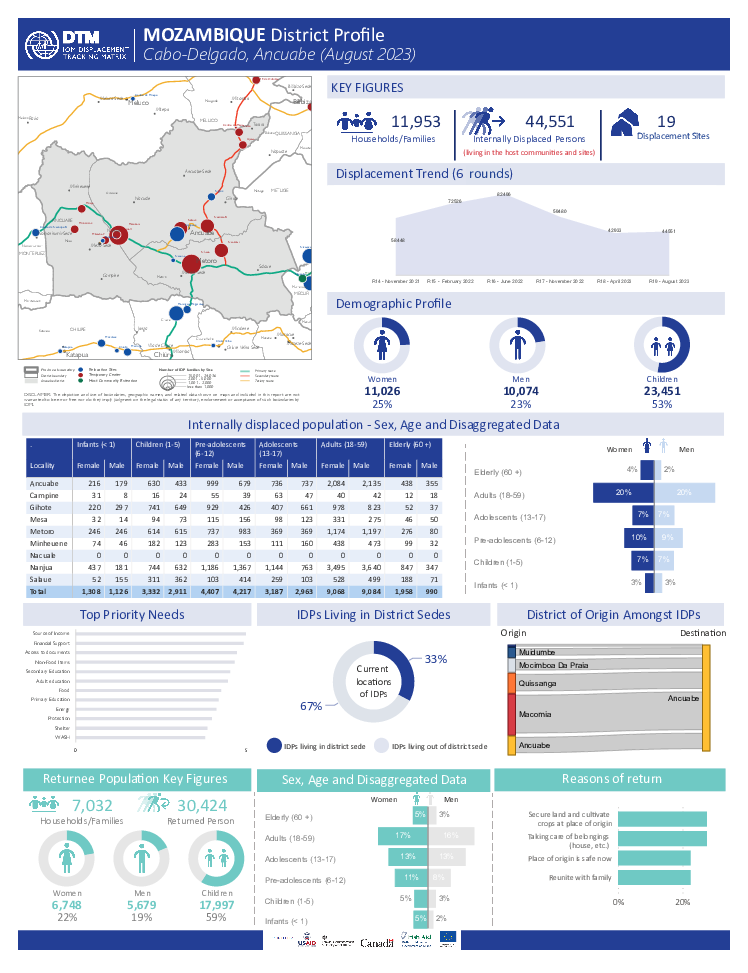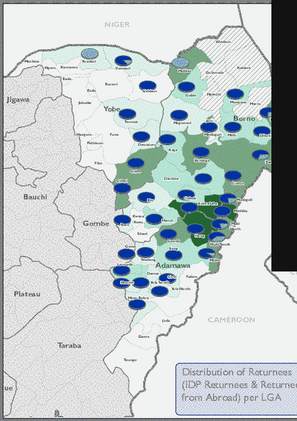-
Countries
-
Data and Analysis
-
Special Focus
-
Crisis Responses
Site Assessment
The Central African Republic (CAR), which has experienced continuous volatility for the past two decades, has been riddled by a crisis which ignited in 2012 with a violent takeover of power and has developed into a complex protracted state of permanent insecurity and fragility which has spilled over into neighbouring countries. The crisis is characterized by power struggles amongst elites, the absence of state institutions and public investment, religious and ethnic tensions and disputes for the control of key resources. More recently, the crisis in Sudan, which started in April 2023, is affecting the eastern part of the CAR witnessing arrivals of displaced populations. As of August 2023, 3,865,278 individuals were affected, including 514,547 internally displaced persons (13% of the displaced population), 2,063,885 returnees former IDPs (54%), 503,019 returnees from abroad (13%) and 783,827 refugees (20%). In the CAR, the largest displaced population consists of former IDP returnees. Refugees from the CAR are primarily hosted by Cameroon (352,938 individuals, or 45% of the refugees), the Democratic Republic of the Congo (DRC) (211,274 individuals, or 27% of the refugees) and Chad (128,083 individuals, or 16% of the refugees). Nonetheless, 24,370 refugees from the Central African Republic are still living in Sudan (3% of the refugees). Since the beginning of the Sudan crisis, a total of 15,335 individuals have entered the CAR through the border in Am-Dafock. The country is home for refugees from neighbouring countries, hosting a total of 34,493 refugees coming from Sudan (24,017 individuals), the DRC (6,410 individuals), South Soudan (2,731 individuals) and Chad (1,335 individuals).
Contact
DTM Mozambique, DTMMozambique@iom.int
Location
Mozambique
Activity
- Mobility Tracking
- Site Assessment
Period Covered
Jul 12 2023 -Aug 04 2023
This summary presents findings of the 19th round of Mobility Tracking Assessments (previously known as Baseline Assessments) conducted across Northern and Central Mozambique through key-informant assessments and group interviews at location level between July and August 2023. Mobility Tracking assessments estimate the presence of internally displaced persons (IDPs) and returnees across Mozambique. IOM DTM mapped a total of 850,599 IDPs and 571,468 returnees in 325 locations. Overall increase on the number of IDPs and Returnees is attributable to the widened coverage. Comparing with previous assessments which covered only Northern Mozambique, the July-August 2023 assessment was widened to cover Manica, Sofala, Tete and Zambezia provinces.
Population Groups
Survey Methodology
Unit of Analysis Or Observation
Type of Survey or Assessment
Keywords
Geographical Scope
Administrative boundaries with available data
The current dataset covers the following administrative boundaries
Returnees by LGA
Contact
DTM Nigeria, iomnigeriadtm@iom.int
Location
Nigeria
Activity
- Mobility Tracking
- Site Assessment
Period Covered
Dec 28 2022 -Feb 04 2023
A site assessment is a sub-component of mobility tracking. It aims to collect data on population presence, living conditions and needs in a particular displacement site or community. Data collection for IDPs took place between December 2022 and February 2023 in 2,482 localities in the six states of north-east Nigeria (Borno, Adamawa, Yobe, Gombe, Taraba and Bauchi). As of February 2023, the DTM identified 2,388,703 IDPs in 488,163 households. The IDP population included IDPs in camps and camp-like settings (834,836 individuals or 35%) and IDPs residing in host communities (1,553,867 individuals or 65%).
Population Groups
Survey Methodology
Unit of Analysis Or Observation
Type of Survey or Assessment
Keywords
Geographical Scope
Administrative boundaries with available data
The current dataset covers the following administrative boundaries

Contact
DTM Mozambique, DTMMozambique
Language
English
Location
Mozambique
Period Covered
Jul 12 2023
Aug 04 2023
Activity
- Mobility Tracking
- Site Assessment
This summary presents findings of the 19th round of Mobility Tracking Assessments (previously known as Baseline Assessments) conducted across Northern and Central Mozambique through key-informant assessments and group interviews at location level between July and August 2023. Mobility Tracking assessments estimate the presence of internally displaced persons (IDPs) and returnees across Mozambique. IOM DTM mapped a total of 850,599 IDPs and 571,468 returnees in 325 locations. Overall increase on the number of IDPs and Returnees is attributable to the widened coverage. Comparing with previous assessments which covered only Northern Mozambique, the July-August 2023 assessment was widened to cover Manica, Sofala, Tete and Zambezia provinces.
Contact
DTM Libya, DTMLibya@iom.int
Language
English
Location
Libya
Snapshot Date
Aug 31 2023
Activity
- Mobility Tracking
- Site Assessment
Detention Centre Profiling is a component of IOM Libya’s Displacement Matrix programme. It is a data oriented tool that routinely provides specific sex and age demographic data and key sectorial information on individuals held in Libya’s detention centres on the date of assessment.

Contact
DTM Ethiopia, DTMEthiopia@iom.int
Language
English
Location
Ethiopia
Period Covered
Nov 25 2022
Jun 29 2023
Activity
- Mobility Tracking
- Site Assessment
- Village Assessment
Between April and June 2023, IOM DTM deployed Site Assessment (SA) Round 33 and Village Assessment Survey (VAS) Round 16, carrying out a multisectoral location assessment in Tigray region, and a figure update in selected high mobility locations across the rest of Ethiopia. The November 2022 - January 2023 data (Round 32 for SA and Round 15 for VAS) was compiled with the April - June 2023 data (Round 33 for SA and Round 16 for VAS) to consolidate national IDP and returning IDP figures updated to June 2023. The locations assessed during both rounds of data collection are not duplicated in the consolidated figures.
As of June 2023, 4,385,789 IDPs (872,483 IDP households) were internally displaced across 3,393 assessed, accessible sites in Ethiopia. Conflict is the primary cause of displacement and displaced 2.9 million IDPs (66.41%), followed by drought which displaced 810,855 IDPs (18.49%). Somali region hosts the highest number of IDPs primarily displaced by drought nationwide (542,807 individuals or 66.94% of national drought caseload), while Tigray region hosts the highest number of IDPs primarily displaced by conflict nationwide (1,011,636 individuals or 34.73% of national conflict caseload).
As of June 2023, IOM DTM estimated 3,238,803 returning IDPs (737,873 returning IDP households) across 2,754 assessed, accessible villages in Ethiopia. The highest returning IDP caseloads nationwide were in the regions of Amhara (1,422,074 returning IDPs, 43.91%), Tigray (1,256,297 returning IDPs, 38.79%) and Afar (194,968 returning IDPs, 6.02%).

Contact
IOMPERUDTM@iom.int
Language
Spanish
Location
Peru
Period Covered
Apr 01 2023
May 31 2023
Activity
- Mobility Tracking
- Site Assessment
Esta ficha informativa ofrece una visión general de los resultados de la primera ronda de la Evaluación de Sitio en Albergues temporales de Lima Metropolitana, las primeras dos rondas de la Evaluación de Sitio en Albergues temporales en la regiones Piura y Lambayeque.
La DTM Yaku se trabajó bajo el componente de Seguimiento de Movilidad de la DTM con la herramienta de Evaluación de Sitio, la cual fue aplicada a los/as gestores o representantes (mayores de 18 años) de los albergues previamente mapeados y fue aplicada a través de un cuestionario estructurado.
La evaluación de sitio se basó en 10 indicadores divididos en siete ejes: (1) medios de subsistencia, (2) servicios y artículos no alimentarios, (3) salud, (4) educación, (5) seguridad y protección, (6) seguridad alimentaria y (7) soluciones duraderas. Los indicadores describen las condiciones críticas o mínimas necesarias de los albergues instalados tras las fuertes lluvias e inundaciones. Los mismos indicadores han sido trabajados para las otras regiones en estudio. Para más información sobre la metodología e informe completo (https://dtm.iom.int/es/peru).
Pagination
- Previous page
- Page 18
- Next page


